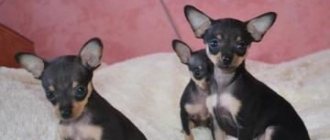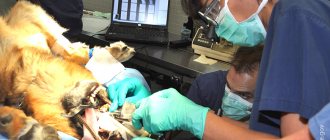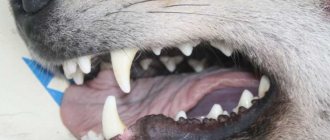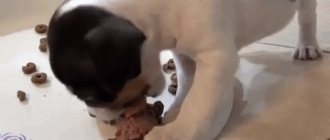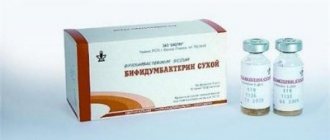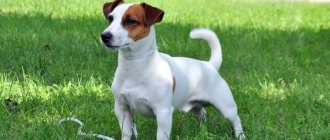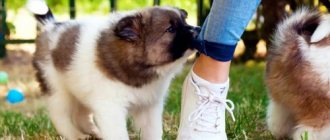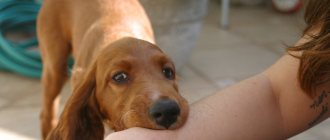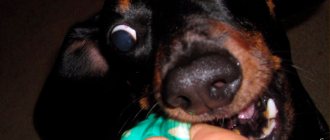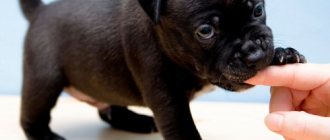Changing teeth in dogs is a stressful time for both the pets themselves and their owners. At this time, you need to be especially attentive to the puppies and check the condition of the oral cavity every day. After all, the dog’s quality of life depends on its health. How teeth change in dogs, at what age milk teeth fall out and a bite is formed - all this is detailed in the article below.
Puppies change teeth
At what age are baby teeth replaced by permanent teeth?
By the end of the first year, the puppy should have a healthy grin consisting of 42 teeth. Any deviation from their quantity, to a lesser or greater extent, may be caused by disturbances in the puppy’s intrauterine development or by a gene mutation.
Also, after replacement, they acquire a yellowish tint.
Owners of puppies need to know what teeth change in dogs is and at what age it occurs. Important! Acceptable angles of tooth growth and occlusion vary among different breeds. Therefore, before deciding that this deviation is necessary, you need to familiarize yourself with the breed standards.
Different types of bites
Each deviation from a normal grin has its own name:
- undershot - there is a large gap between the incisors;
- pincer-shaped - straight;
- scissor-shaped - normal;
- bulldog-shaped - the lower jaw is more developed;
- undershot - the lower incisors stand out more than the upper ones.
As dogs age, their dental crowns wear down and their fangs wear down. If the bite is correct, then these processes proceed evenly and do not interfere with older animals.
Normal bite
Care and maintenance of Jack Russell puppies
Features of care
Jack Russell puppies are strong and healthy; babies of this breed do not need labor-intensive and expensive grooming, but the owner must carry out the following procedures regularly:
- Eye care . Wipe your eyes in the morning using a dry cotton pad or a regular paper napkin. A healthy puppy has almost no discharge from the eyes, so he does not need to use special solutions.
- Ear care . The ears are wiped once a week, cleaning the shell with a cotton pad soaked in a solution of Chlorhexidine.
- Grooming . _ The coat of a smooth-haired baby is combed with a special brush, which not only removes loose hairs, but also gently massages the skin.
- Paw care . Your pet's nails wear down naturally when he walks a lot on hard surfaces. Walking on gravel or asphalt helps strengthen the ligaments and wears down the claws. But if the claws grow so long that they interfere with the puppy’s walking, he begins to lame and the posture of his limbs is formed incorrectly. The claws are trimmed with a special guillotine, trying not to touch the nerve and blood vessel located just above the edge.
Content Features
The Jack Russell puppy is stubborn and able to make decisions on his own, has a wild temperament and requires as much attention as possible . Dogs of this breed cannot live in an enclosure or on the street, are not able to sit on a chain and love comfort. Apartment housing implies early training in neatness, and the puppy must be trained to use the toilet outside, without waiting for the end of the vaccination quarantine. Otherwise, the stubborn terrier will make puddles indoors for a very long time, and it will be difficult to wean him from this habit.
Walking and playing are little Jack's favorite activities . A puppy of this breed has enough energy to pester family members for many hours with a toy in his mouth, to strive to track down and catch up with the neighbor's cat and to eat any garbage. The kid will dig huge holes in the flower beds, tear at the bushes and try to tear the canopy over the swing in the garden, and also start quarrels with his fellow tribesmen on the playground.
The owners of a puppy of this breed can only dream of peace, since the pet requires almost round-the-clock attention . To prevent damage to things, as well as for the safety of the puppy itself, you need a crate where the baby will spend time in the absence of the owners. By locking a pet in it, owners can be sure that the fidget will not chew electrical wires or damage the upholstery of upholstered furniture.
Important! A crate for a Jack Russell puppy is a cozy home with a rug and toys, not a prison.
When walking, it is better not to let a puppy of this breed off the leash, as he may get carried away chasing a bird or a cat or get hit by a car. A roulette leash is perfect for walking, the length of which is automatically adjusted.
Teething order
When a dog begins to change teeth, its owner needs to monitor this process. Therefore, the mouth must be examined every day. The order of eruption varies among breeds.
In representatives of large breeds, this process goes faster, and problems with grinning rarely occur. Regular examination allows you to see which teeth will fall out.
Owners of large breed dogs can pull out a loose tooth themselves. To do this, you need to loosen it and tear it out using a clean gauze napkin. There will be no problems, because the roots of the baby teeth have practically dissolved by the time of the change.
In dogs of medium and small decorative breeds, for example, Chihuahuas or Yorkies, spaniels, corgis, poodles, this process is accompanied by difficulties. They are predisposed to problems with their teeth. Most often they have a “second row”. Therefore, their owners often turn to veterinarians for help. They also have to carefully monitor the puppy’s nutrition.
Consequences
The dog has a number of consequences and complications, such as:
- digestive problems associated with poor quality of chewing food and insufficient processing of the food bolus with saliva, which leads to stool disorders, deterioration in the absorption of nutrients from food, and chronic diseases of the gastrointestinal tract;
- injury to the mouth cavity (tongue, gums, palate) during intensive chewing of food is the cause of the formation of inflammatory processes and various diseases, leading to a large number of complications;
- Constant drooling leads to the appearance of weeping eczema and dermatitis on the dog’s face.
Symptoms of the onset of teeth change
Many owners do not notice the stage when dogs' teeth change. Because milk may fall out while eating.
Each puppy will have its own symptoms of the onset of teeth replacement. But there are common signs:
- restless behavior;
- frequent whining;
- apathy;
- the puppy often rubs its muzzle with its paws;
- the pet does not eat well or may lose appetite;
- slight increase in temperature;
- drowsiness;
- diarrhea;
- the puppy often gnaws and chews various objects;
- the pet does not allow you to examine its mouth;
- there is a smell from the mouth.
Normally, this process proceeds without alarming signs. The puppy can continue to chew because teeth have begun to cut, while remaining active and inquisitive. Therefore, owners should remove valuables.
The puppy starts chewing things
Upbringing
There are 3 types of training: burrow hunting, searching for wounded animals, game hunting, including pursuit on the ground. Owners themselves decide which is preferable for their plans. Training begins at 8-10 weeks of age and takes place in a playful way. With age, classes become more difficult.
- They build obstacles and use incentives. The animal is characterized by temperament and unconditional obedience must be curbed.
Self-confidence, pressure, activity are manifested from a young age. If you let your pet's life take its course, it will educate itself.
The result will be damage to furniture, shoes, carpets, books, and cords. Holes will form in the sofas, and the Internet, TV and washing machine will stop working. Become the leader of the pack, the dog will obey the leader.
Scheme of changing baby teeth in puppies
All puppies, with rare exceptions, are born without teeth. Therefore, they are under the full care of their mother. At 2-3 weeks, the first milk teeth appear according to a certain pattern.
Important! Violation of the order of eruption does not play a big role, provided the bite is correct.
Standard scheme for changing the dentition:
- incisors located in the center, on the lower and then on the upper jaw;
- lateral incisors;
- One-month-old puppies develop fangs: first the lower ones, and then the upper ones. But usually this happens in any order.
In total, the puppy should have 6 baby teeth on each jaw. The appearance of fangs begins to interfere with the sucking of mother's milk. Therefore, the puppy looks for other sources of food. At this age, complementary foods are already being introduced.
Further, depending on the individual characteristics of the puppy, premolars appear in the period from 3 to 6 weeks. Premolars are the teeth that are located immediately behind the canines. By 8 weeks, the dentition should consist of 28 teeth:
- 12 incisors;
- 4 fangs;
- 12 premolars.
Then the indigenous ones replace the dairy ones according to a certain pattern:
- Between 3 and 4 months, the front incisors are the first to fall out. By 5 months, the puppy should have all its molar incisors.
- From 5 to 6 months the canines change. They may only appear, but not grow for 2-3 months.
- Premolars fall out at 6-7 months.
Normally, by the seventh month, all of the puppy's baby teeth should fall out. By 10 months, indigenous ones appear in their place. There should be 42 teeth in total.
Important! During the period of molar replacement, gum inflammation may occur. Therefore, it is necessary to inspect the mouth regularly.
Possible pathologies
A mandatory examination by a veterinarian is required at the moment when an adult dog’s molars begin to fall out. If her age is far from elderly, then the cause of the disorder lies in pathology.
Oral diseases
Dental diseases affect soft mucous or hard bone tissue. The most common diseases include the following:
- caries
– putrefactive destruction of hard tissues, often complicated by periodontitis and pulpitis;
- periodontitis
– an inflammatory process involving the connective tissue between the hole and the root;
- pulpitis
– inflammation of internal tissues, including nerves and blood vessels;
- stomatitis
– damage to the oral mucosa;
- gingivitis
– an inflammatory process that covers exclusively the gums and does not affect external soft tissues;
- periodontitis
– a complication of gingivitis that affects all surrounding tissues.
All these diseases require mandatory treatment, since very often they are complicated by secondary infections. Also, when the process is running, the likelihood of losing not only part, but the entire dentition increases.
Bacterial and viral infections
Bacteria and viruses that enter the mouth directly or from neighboring organs are usually to blame for the occurrence of the pathologies discussed. Their waste products cause acute intoxication. The body uses an inflammatory response to destroy the pathogen.
Improper feeding
When feeding exclusively soft foods, the gums soften, causing premature loosening. There is also a rapid accumulation of plaque, which gradually hardens into stone. The quality of enamel deteriorates, causing the development of caries.
Eating tubular bones is no less dangerous. They injure soft tissues, opening the way for pathogens.
Injuries and tumors
The cause of the problem can be severe maxillofacial injuries associated with mechanical damage. In this case, the animal loses its snow-white smile immediately upon being hit or bruised.
It is also recommended to check the dog for the presence of tumors. Malignant tumors have a destructive effect on the mucous membranes.
How to help a puppy with teeth changes
During this period, you need to show more attention and care towards your pet. When puppies are teething, they need to constantly chew on something. Therefore, the owner should make sure that the dog has something to chew. To prevent the appearance of inflammation or other abnormalities in the formation of grins.
Massaging the gums with a soft silicone brush is useful. It wouldn't hurt to buy special toys. If you have any alarming symptoms, you should contact your veterinarian.
The puppy may not allow you to examine the oral cavity
How to feed your dog correctly during this period?
When puppies lose their baby teeth, there is no need to specifically change their diet. The pet continues to be fed with the same food. Dry industrial food partially removes plaque and also massages the gums when grasping granules.
With natural feeding, the resulting food may be too soft. In this case, the pet should additionally be given special treats that will create a load, strengthening the periodontium. In addition, soft food lingers to a greater extent on the enamel, gradually forming tartar.
Expert opinion
Kuzmenko Olga Olegovna
Information about the expert
Ask a Question
It is not recommended to include additional mineral supplements (including calcium) in your pet’s diet without consulting a veterinarian (especially when feeding industrial feed).
What can you chew to relieve itchy gums?
In nature, puppies chew branches and sticks for this purpose. If possible, you can bring them home. There are also a number of things that will help solve this problem:
- toys made of durable material (it is advisable to change them after a few days so that the puppy does not lose interest in them);
- teethers;
- healthy treats;
- large articular bones;
- vegetables and fruits;
- wood, preferable to fruit trees.
If the puppy does not have things that he can chew, then he will begin to damage furniture, shoes and other valuables. This can also be made part of training, teaching your pet to chew on certain objects.
Risk group by breed
The risk group includes small representatives of decorative breeds. With a normal dentition size, their jaw is more compact in size and has thin bone. Such animals include:
- Spitz;
- toy terriers;
- chihuahua;
- Yorkies;
- Pekingese;
- Japanese chins.
In addition to the genetic predisposition to the listed pathologies, such pets often suffer from persistence - an unusual anomaly in which both dentitions are preserved. This problem can only be solved surgically.
Possible complications
When the process of changing teeth begins, the owner must carefully monitor the well-being of his pet and the condition of his oral cavity. Experienced dog lovers advise showing the puppy to a veterinarian. This period may be accompanied by complications.
Gum inflammation
It may occur for the following reasons:
- the appearance of too large teeth;
- “hoods” of gums in which food debris accumulates, which triggers the process of inflammation;
- incorrect diet.
If the inflammatory process is too severe, then the puppy is given procedures to maintain oral hygiene or given special medications.
Delayed tooth change
In this case, the molars appear before the mammary ones fall out. This can cause malocclusion and crooked teeth. Also, the roots of the dairy plants begin to rot. The problem can only be solved surgically.
Diarrhea
Diarrhea often accompanies changing teeth and usually goes away without intervention. The owner should monitor for development of dehydration. The smaller the puppy, the faster he loses water.
Attention! If your pet develops a fever or vomiting as a result of diarrhea, it should be taken to the vet immediately.
The puppy may be lethargic and this is worth paying attention to.
Smell from the mouth
Most often this is a sign of rotting. The causes of unpleasant odor are various:
- it may be caused by food debris;
- the appearance of pathogenic microflora in the mouth;
- disruptions in the gastrointestinal tract.
If, during an external examination of the mouth, the owner did not find anything strange, then you need to consult a specialist. Based on the data obtained, he will be able to determine the exact cause of its occurrence.
Poor appetite
This is a completely normal reaction of the body to discomfort. You should be concerned if the puppy refuses not only food, but also drink. The dog eats poorly due to discomfort, so you can make it easier for him to eat by switching him to liquid or ground food.
Attention! If lack of appetite is accompanied by fever, vomiting, diarrhea, then you should consult a specialist.
What to buy for a Jack Russell Terrier puppy
Before purchasing a puppy, you need to buy a few essential things for him . The baby will need:
- Two bowls, preferably on a stand. The naughty boy will turn over floor bowls while playing with water.
- A soft rug, bed or foam house.
- Small soft collar and roulette leash. It is better to immediately take a leash based on the weight of an adult jack. The harness is purchased only after trying it on.
- Soft and rubber toys, squeakers and balls, a whole beef bone. The sinew bones are too hard for a small puppy, so he won't play with it.
- A large crate designed for an adult dog.
- If you adopt a puppy during the cold season, then you need to buy or make a warm blouse or overalls for him.
The list of things a dog needs will eventually be replenished with hypoallergenic shampoo, a rubber brush, vitamins, new toys and new things. Your puppy will need tick repellents, various treats, and a brush to help care for his teeth.
Types of bite and its disorders
Every dog owner needs to know the types of bites and deviations from the norm. It is worth noting that for some breeds, deviations are due to genetic characteristics, and they are specified in the standards.
- Correct - the teeth of the lower jaw are behind the upper jaw. There is not much distance between them.
- Straight is normal for certain breeds. All incisors are connected along one line.
- Underbite is a deviation. There is a large gap between the incisors.
- Snacking is also standard for some breeds. The lower incisors “overlap” the upper ones.
Therefore, if you have any alarming symptoms, you should contact your veterinarian.
Puppy at the veterinarian's appointment
First vaccinations
At 21 days, the puppy and mother are dewormed. This is usually done with a suspension of Drontal Junior, Pirantel and other drugs.
At 4-6 weeks they are vaccinated against distemper and parvovirus enteritis.
At 3-9 weeks the following vaccinations are given:
- repeatedly from plague and parvovirus enteritis;
- from hepatitis;
- from parainfluenza;
- from leptospirosis.
At 12 weeks, revaccination against distemper, hepatitis, parvovirus enteritis, and leptospirosis is carried out. Vaccination against rabies is carried out.
At 6-8 months after changing teeth, revaccination against distemper, hepatitis, parvovirus enteritis and leptospirosis is carried out.
Breed characteristics of tooth change
Each breed has its own standards that their representative must meet. They also describe the characteristics of the bite. Before buying a representative of any breed, you need to ask whether the dogs have milk teeth and in what quantity. This will determine the condition of the bite.
You need to take care of your teeth
German Shepherd
There are no special features in the formation of the bite. The norm for a German Shepherd is scissor-shaped. Any violations are regarded as deviations.
Labrador
Everything is similar to the German Shepherd.
Spitz
The smaller it is, the higher the risk of problems with the oral cavity. But the standard allows only a scissors bite.
Jack Russell Terrier
Like the German Shepherd and Labrador.
Laika
The standard allows only "scissors". But huskies often have problems with bite formation.
Dachshund
The Dachshund has standards similar to the Jack Russell Terrier.
Yorkshire Terrier
Very often there are problems with changing teeth. Often, Yorkshire Terrier owners have to remove them from their pets because they do not fall out in a timely manner. Therefore, terriers need to be brought in for a veterinary examination once every 6 months.
Pug
A pug can also cause trouble for its owner. A pincer bite is considered normal. Also included in the standards is a small undershot - up to 3 mm.
Boxer
Despite good health, he often has problems with the oral cavity. It has a special standard: a limited bite with the closure of the fangs is considered correct. Similar to the French bulldog.
Each breed has its own standard
What price?
Many breeders specialize in breeding certain types of dogs. This requires a wealth of knowledge and special care to maintain the quality of the breed. Even a buyer should know all the physical characteristics of a puppy before deciding to buy it. As a rule, animals from a reputable breeder are registered with a reputable kennel club. In addition, he spends a huge amount of money to provide them. So, the starting price of a puppy with documents from a reputable breeder is 35,000-45,000 rubles. If you decide to purchase a puppy from titled parents, be prepared to pay 80,000 rubles . And if there are not so many championship titles or not at all, then the price is reduced by two or three times.
Puppies without a pedigree can be purchased from 10,000 to 15,000 rubles . If the cost is less than 10,000, then most likely they are offering you a sick dog. Grown-up specimens cost about 25,000, but be prepared to invest in a professional trainer.

